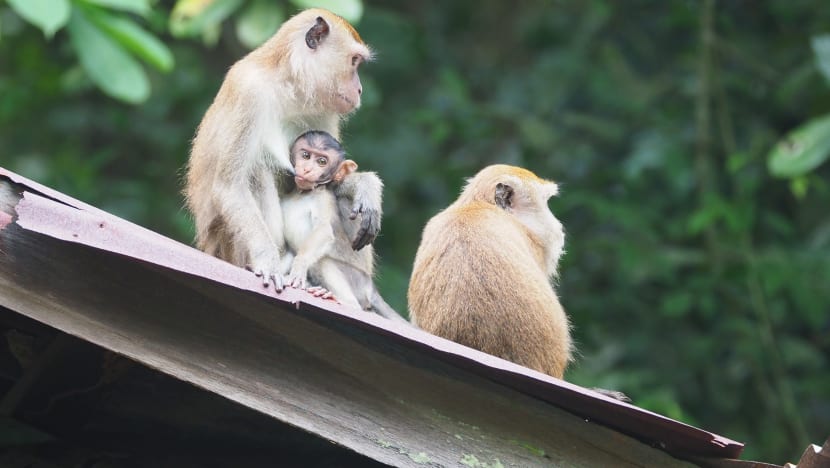commentary Commentary
Commentary: To reduce wildlife attacking humans, stop feeding them
It is time to get serious about both education and enforcement when it comes to feeding wildlife in Singapore, says SPCA’s Executive Director.

In 2017, residents at Segar Road in Bukit Panjang were attacked by an aggressive monkey which entered their flats and stole food.
SINGAPORE: In our development as a nation, we have converted most green spaces in Singapore to meet human needs.
While we have made an attempt to incorporate nature into our urban environment, the shrinking of natural habitats will inevitably lead to more intimate interactions between humans and wildlife.
The recent encounter between a woman and a wild boar at Sungei Api Api reinforces some of the challenges that will occur when a jungle turns concrete.
This wasn’t the first such incident – there were other instances over the past year of boars, otters, monkeys and hornbills coming into close contact with humans and these instances will continue.

There are many reasons why conflict between humans and wild animals may occur. A significant contributor to the problem is the act of feeding these animals.
Such cases are regularly reported. A group was caught feeding wild boars during the circuit breaker and in early December, a man was captured on video feeding two hornbills at Loyang Way Food Village. NParks is investing the incident.
READ: IN FOCUS: How urbanised Singapore is learning to live with its wildlife
READ: Commentary: The truth behind returning wildlife is less feel-good than you think
Many who feed may not understand the problems associated with feeding animals in the wild. This may explain why this has been a very longstanding issue, one that has been brought to the fore by sharing on social media.
These feeding videos usually attract a lot of attention and draw strong reactions.
NEGATIVE OUTCOMES FROM FEEDING
Survival in the wild requires the securing of food, usually a scarce resource.
Food is thus one of the most important motivators and drivers of animal behaviour. Feeding wild animals can therefore alter their behaviour in significant ways.
Keeping this understanding of animal behaviour in mind can help us appreciate why feeding wild animals can then motivate animals to approach humans again and again for food.
When someone feeds a macaque, the macaque learns that humans are associated with food. This then explains why the monkeys grab your belongings as you stroll by.
And when these wild animals start to lose their fear of us and keep coming up close, incidents involving bites and scratches may occur.

Understanding the capacity of a natural environment to support life is another aspect to consider. Let us take Pasir Ris Park for example. The park has a limited amount of water, food, plants, minerals, shelter and other natural resources required for wildlife sustenance.
READ: Commentary: The truth behind returning wildlife is less feel-good than you think
This naturally keeps populations in check. However, when a person brings in loaves of bread to feed the wild boars, this artificially increases the carrying capacity of the ecosystem.
The artificial tilt in capacity could result in a larger wild boar population which the natural environment cannot sustain, forcing the animals to venture further and placing them in closer proximity with humans.

The altered behaviour and increased populations will likely lead to conflict with humans and concerns for public safety, resulting in some asking for the animals to be removed or culled.
The recent survey run by Senior Minister Teo Chee Hean and his team found a number of residents that participated wanting the animals entirely removed.
For wild boars, the percentage calling for complete removal was 39 per cent, though chickens fared much better at 7 per cent. It was 21 per cent for "other wild animals".
Yet, wishing the animals would go away doesn’t really solve the problem. It may be useful to also understand how our actions impact them. One consequence most people are not aware of is how feeding results in an unbalanced diet for the animals.
It is not uncommon to see calorie dense, nutrient light and processed food being fed to wild animals. Food items like white rice or bread are commonly fed to a variety of species. These high carbohydrate meals lack many of the nutrients animals need.
The result could be suppressed immune systems and higher incidences of disease, affecting the animals’ quality of life.
WHY DO PEOPLE DO IT?
If there are negative and serious outcomes from feeding, why do people still do it?
A big factor is that many people enjoy interacting with animals. Most who feed are not leaving the food on the ground and then immediately leaving the spot. They try to lure the animals closer, wait for them to approach and either watch them eat from a close distance or even go to the extent of hand feeding.
The intention is to have some form of engagement and connection with the animal. I sympathise with them as I too intensely enjoy interactions with animals.

Another common reason is that the feeder is attempting to help the animal as they feel sorry for them. Some serial feeders whom I have spoken to mistakenly believe the animals might starve as they think the habitats the animals live in do not provide them enough food resources.
They do not realise that the animals can find their own food in the forests, food which will be much healthier for them as well.
Well run institutions housing wild animals take great pains to research and develop science based feeding guidelines for the animals under their care.
A nutritionist will tell you that this is not a simple process. So there is little chance that even a well-meaning individual can provide a balanced and healthy diet for a wild animal.
EDUCATION AND ENFORCEMENT
I do not think anyone feeding a wild animal means to cause harm. However, the consequences for the animals, humans and the larger ecosystem can be severe. Our approach to the problem thus needs to keep these two points in mind.
Education will always need to form a large part of any strategy to deal with the issue and this will need to be an ongoing effort.
For those who yearn to connect with animals and nature, there are non-harmful ways to enjoy animals in the wild including observing them from a safe distance. A pair of binoculars is always useful when animal spotting.
READ: Commentary: Are we inept at handling wild animals that come our way?
One can also join a structured nature tour if you want to enjoy wildlife but don’t know how or where to look.
We however cannot escape the need for stern and effective punishment to deter potential feeders. After all, various groups have been putting out educational messages asking the public to not feed wild animals for years and there are plenty of signs put up in nature reserves and parks. Still, feeding continues at a non-insignificant level.
In March this year the Wild Animals and Birds Act was renamed the Wildlife Act and stiff penalties for feeding wild animals were introduced. First time offenders can be hit with a fine of up to S$5,000.
For the second and subsequent offence, one could be fined up to a whopping S$10,000.
So it remains to be seen if these stiffer penalties will make a difference in addressing these behaviours.
My suggestion is that for those who continue to feed, and even for first time offenders, a rehabilitative approach that incorporates education on the ills of feeding wildlife, together with a volunteering component, might be more effective than just punishment.
From our experience, some feeders go to great lengths to avoid enforcement officers, playing hide and seek and wasting agency resources in the process. Perhaps some might stop feeding if they fully understood the consequences of their actions, rather than just being told not to feed.
Feeding of wild animals is a recreational activity. We do it because it is enjoyable and we feel sorry for animals but it does so much harm in the long run and this is the message that needs to reach everyone if we are to protect the wildlife – and ourselves.
Listen to an expert discuss why conserving forests and mangroves is critical to our fight against climate change:
Dr Jaipal Singh Gill is Executive Director of SPCA in Singapore.














